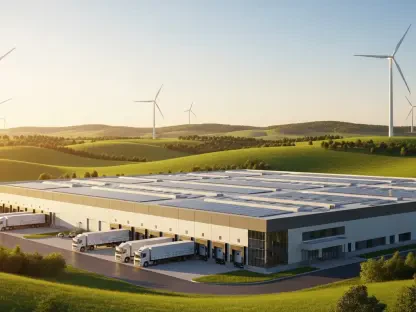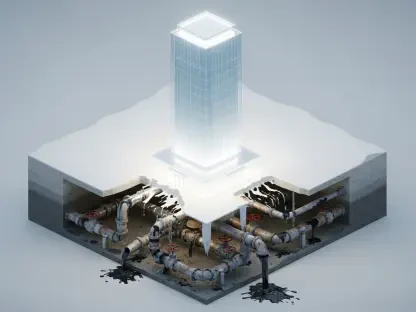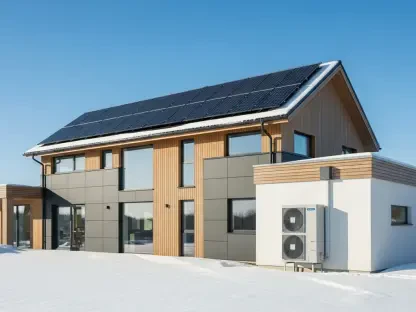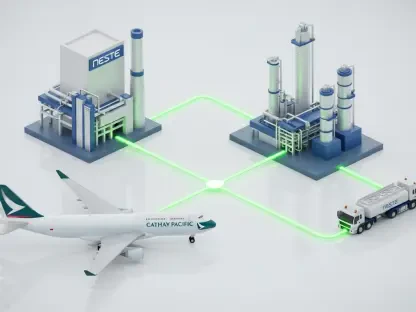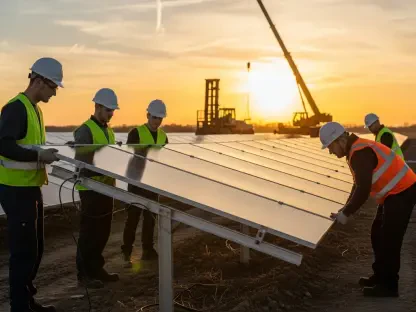Nuclear energy companies are engaged in a vigorous race to develop microreactors. These “mini batteries” are driven by a need for affordable, safer, and more modular energy solutions. This shift is seen as a significant step in supporting decarbonization efforts across various sectors. Over recent years, nuclear energy has notably progressed, marked by advances in US nuclear deployment targets, historic reactor restarts, and new reactor implementations. These advancements align with new climate targets set by many nations striving for renewable energy sources to meet their green goals. Although Europe lags behind the US, countries like Romania, France, and Bulgaria have increased their nuclear investments and projects.
The Rise of Microreactors
A New Era in Nuclear Energy
Nuclear reactors serve multiple sectors, including oil production, power generation, manufacturing, and desalination. They’re also crucial in research facilities, nuclear power plants, and the propulsion of ships like icebreakers and submarines. Even consumer goods such as clocks, watches, smoke detectors, and non-stick cookware rely on small quantities of radioactive material. Recently, nuclear energy companies have aimed to downsize reactors to accelerate zero-carbon energy production and reduce sectors’ dependency on electric batteries. These smaller reactors, comparable to shipping containers in size, act like miniaturized batteries. This downsizing seeks to enhance nuclear energy’s accessibility and adaptability across a broader range of applications.
By shrinking the size of reactors, companies seek to bring nuclear energy into spaces where larger reactors wouldn’t be feasible. The objective is to make nuclear power more versatile and widely applicable. Whether in remote scientific outposts or small industrial facilities, these compact nuclear power modules could provide a steady supply of clean energy. The compact design also means quicker deployment and potential interlinking of multiple units, offering a scalable solution to changing energy demands without the need for significant infrastructural changes. This adaptability could revolutionize how we approach not only power generation but also distribution, with the potential to weave nuclear energy seamlessly into our existing energy grids.
Advantages of Microreactors
Microreactors’ ability to yield clean and reliable energy without needing frequent refueling makes them appealing. Their passive safety features decrease the risk of radioactive releases, making them safer than traditional reactors. Furthermore, microreactors are more affordable and modular since they can be factory-built and installed in modules as needed. Their versatility extends across numerous applications, including water desalination, district heating, military bases, and more. They eliminate the need for on-site workers or control rooms, which lowers labor costs and allows for more autonomous operations across different sectors.
This modular construction means that microreactors can be integrated as the energy demands of a locality scale. The small footprint and operational independence of these units promise a revolution in places where resource access and labor are limited. This autonomous operation extends far beyond mere convenience. With automated systems, response times to any potential issues are faster and more accurate, potentially preventing incidents before they become critical. This reduced human participation also minimizes the risk of human error, thus improving overall safety. Furthermore, the ability to distribute microreactors across a wide geographic area without necessitating extensive infrastructure supports remote community energy needs, thereby promoting regional energy independence.
Decarbonization and Industry Applications
Replacing Fossil Fuel Generators
One of the main incentives for shifting to microreactors is the goal to replace fossil fuel-powered generators with clean energy alternatives to support global decarbonization endeavors. Currently, gas and diesel generators are heavily utilized across diverse industries, including agriculture, manufacturing, healthcare, construction, education, transportation, and defense. They are particularly vital for specific operations like offshore oil drilling platforms and data centers. Switching to nuclear microreactors could significantly reduce these industries’ carbon emissions and overall carbon footprint. By providing a clean, continuous power supply, microreactors can help industries meet stringent environmental regulations and sustainability goals.
This transition to microreactors is not just theoretical but could have tangible effects on industrial practices. For instance, agriculture heavily relies on diesel generators for irrigation systems. Here, microreactors could drastically reduce emissions while ensuring uninterrupted water supply. Similarly, in healthcare, where power reliability is critical, microreactors could provide steady energy for hospitals and research facilities without the fluctuations inherent in renewable sources like solar and wind. Data centers, notorious for high electricity consumption, could see significant benefits as well. The stable power provided by microreactors ensures data integrity while supporting massive energy loads with minimal environmental impact. The overall benefits of integrating microreactors into these sectors are profound, both for sustainability and operational efficiency.
Mining Industry Potential
The mining industry has also recognized the potential of microreactors, especially given its current reliance on diesel power for excavation. Diesel is both costly and pollutant-heavy, whereas microreactors offer a clean power supply with a longer performance duration, mitigating these issues. This transformation could lead to cleaner extraction methods and lower overall operational costs. Additionally, the compact nature and durability of microreactors make them suitable for the remote and often harsh environments of mining sites. Their capacity for continuous operation without frequent refueling cycles supports the relentless energy demands of mining operations while reducing environmental impact.
With the mining industry often located in isolated areas, the logistical challenge and cost of fuel transportation have always been a hurdle. Microreactors can alleviate these logistical burdens with their long operational spans and minimal refueling requirements. In terms of safety, microreactors’ passive safety systems reduce the risk of accidents in hazardous work environments. More so, the prospect of reduced emissions from mining operations aligns with broader environmental targets and sustainable mining practices. These cleaner alternatives not only comply with environmental regulations but also enhance the industry’s public image by demonstrating a commitment to sustainable development. The potential paradigm shift in the mining sector underscores the broader applicability and benefits of microreactors, reiterating their critical role in a carbon-free energy future.
Leading the Charge: Westinghouse Nuclear
The eVinci Microreactor
Westinghouse Nuclear leads the microreactor movement, with plans to develop the eVinci microreactor. Expected to deliver around 5 megawatts of electricity for over eight years without refueling, this microreactor aims to provide safe, carbon-free, scalable energy for universities, remote communities, data centers, industrial hubs, and defense operations. It is also capable of hydrogen production, expanding its utility further. The eVinci microreactor’s design emphasizes simplicity, efficiency, and reliability, making it a versatile option for a wide array of energy needs. Westinghouse’s commitment to such innovative solutions reflects the growing movement towards reducing carbon footprints and enhancing energy independence.
The eVinci microreactor’s versatility can transform energy paradigms within sectors traditionally dependent on fossil fuels. By incorporating hydrogen production capabilities, eVinci broadens the scope of clean energy applications, potentially revolutionizing fuel generation for transportation and industry. The self-sustaining nature of the eVinci ensures minimal operational interference, making it adept at supplying energy to isolated or resource-constrained locations. Its modular design allows for scalable implementation, ensuring that energy needs – be they small communities or large industrial complexes – are met efficiently. Westinghouse’s initiative aligns with global trends towards sustainable energy solutions, emphasizing the role microreactors play in diverse and evolving energy landscapes.
Broader Implications and Future Prospects
Despite the promising advancements, nuclear energy faces considerable hurdles to mainstream acceptance. Key concerns include radioactive waste production and management, with improper disposal posing long-term risks to human and environmental health. Historical nuclear disasters like Chernobyl and Fukushima have fueled opposition to nuclear projects due to fears of potential catastrophes. Additionally, worries about nuclear weapons proliferation and associated geopolitical tensions contribute to resistance. Addressing these concerns requires robust regulatory frameworks and innovative technological solutions to ensure nuclear energy’s safe and sustainable growth.
Public perception of nuclear energy is another critical aspect that the industry must tackle. Overcoming the stigma associated with past nuclear accidents involves transparent communication and demonstrated safety measures. Innovative designs like those of microreactors, which inherently include safer operational features, play a crucial part in reshaping public opinion. Advances in waste management and disposal must also keep pace with reactor technology to mitigate the long-term risks associated with nuclear energy use. International collaboration and stringent global standards are essential for addressing nuclear waste issues and promoting nuclear energy as a viable alternative to fossil fuels.
Challenges and Considerations
Health and Environmental Risks
Health risks to uranium miners, notably increased lung cancer rates, also raise alarm. However, one of the most significant barriers remains the high cost of constructing nuclear reactors, often reaching billions of dollars. Although microreactors are comparatively cheaper, they still require substantial investment. The nascent market for microreactors amplifies the challenge of securing investors, particularly amid current economic uncertainties. These health concerns and financial barriers highlight the complex landscape that nuclear energy must navigate to gain widespread acceptance and integration into global energy systems.
Financial constraints extend beyond initial construction costs. Ongoing maintenance, compliance with rigorous safety standards, and secure waste management add to the operational expenses. Despite these challenges, the potential long-term benefits of microreactors – such as reduced operational costs and low carbon emissions – create a compelling case for investment. Incentives and subsidies could play a pivotal role in encouraging investment in this emerging technology. Moreover, advancing reactor designs and construction techniques can help reduce costs over time, making microreactors a more attractive option for investors and stakeholders. Addressing health and environmental concerns transparently and effectively remains vital in building public and investor confidence in microreactors as a sustainable energy solution.
Economic and Market Barriers
Nuclear energy companies are fiercely competing to create microreactors, often dubbed “mini batteries.” These innovations arise from the necessity for cost-effective, safer, and more adaptable energy solutions. This evolution is regarded as a critical milestone in advancing decarbonization across diverse sectors. In recent years, nuclear energy has made significant strides, evidenced by the progress in U.S. nuclear deployment objectives, the revival of historic reactors, and the establishment of new reactors. These developments coincide with recent climate targets as many nations aim for renewable energy goals to achieve their environmental aspirations. While Europe’s progress trails behind the U.S., several countries, including Romania, France, and Bulgaria, have ramped up their nuclear investments and undertakings. The global push for greener technologies underscores the importance of nuclear energy in reducing carbon emissions and securing a sustainable future. This commitment highlights the importance of nuclear power in transitioning to a more sustainable and environmentally friendly energy landscape.


